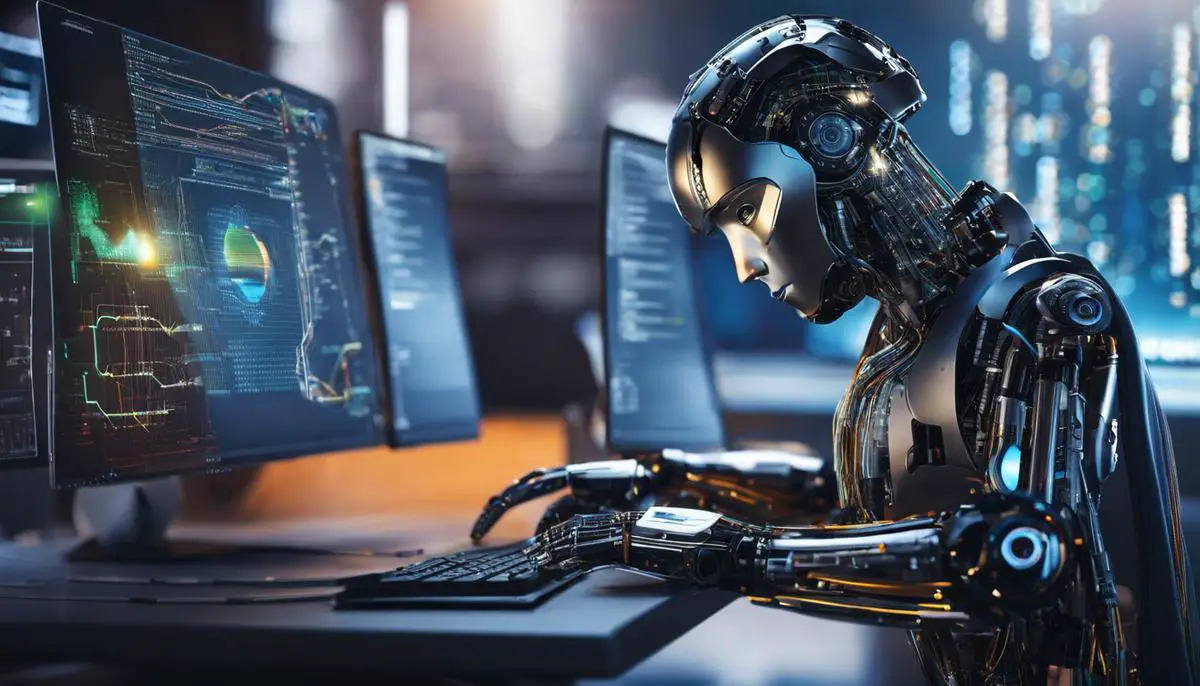AI in Software Engineering: The Hidden Superpower You Didn’t Know About- The role of Artificial Intelligence (AI) has evolved dramatically over the past few years, especially in the realm of software engineering. Software engineers are increasingly leveraging AI in various aspects of their work to enhance productivity, improve code quality, optimize development processes, and enable more intelligent applications. In this article, we’ll explore the practical ways in which software engineers are using AI, from code generation to automated testing, and its impact on the software development lifecycle.
1. Introduction: The Growing Role of AI in Software Engineering
The integration of AI into software development is no longer just a theoretical concept. Engineers are actively adopting AI-powered tools to improve their workflows, solve complex problems, and produce more efficient code. This transformation has made significant strides over the last decade, with AI now being used in everything from writing and testing code to managing infrastructure and enhancing performance.
With AI becoming more accessible, software engineers are beginning to realize its potential not only for improving software products but also for simplifying the development process itself. Whether it’s through code assistance or automated testing, AI tools are reshaping the day-to-day tasks of software engineers.
2. Code Generation and Completion
Code Assistants
One of the most popular uses of AI in software engineering is in code generation and completion. Tools like GitHub Copilot, Tabnine, and Kite provide code suggestions and auto-completions based on context. These tools are powered by large language models (LLMs), which analyze a vast amount of publicly available code to make intelligent predictions.
For example, when a software engineer starts typing a function or class, these AI assistants can predict the next lines of code, suggest function names, and even help with more complex algorithms or library calls. By learning from the developer’s coding style and providing tailored suggestions, these tools help increase coding speed and reduce the cognitive load of developers.
AI-Driven IDEs
Integrated Development Environments (IDEs) like Visual Studio Code, JetBrains IntelliJ IDEA, and PyCharm have incorporated AI-driven features such as auto-completion, code refactoring, and syntax corrections. These tools enhance productivity by providing suggestions for code snippets, correcting errors in real time, and offering best practices based on coding standards. AI-powered IDEs not only provide helpful code completion but also streamline the overall development experience.
3. Automated Code Review and Quality Assurance
Code Linting and Static Analysis
AI plays a key role in improving code quality by helping software engineers detect potential issues before they make it to production. Static analysis tools such as SonarQube, DeepCode, and Codacy use machine learning algorithms to analyze code for potential bugs, security vulnerabilities, and performance issues.
These tools go beyond basic linting, offering deeper insights into coding patterns, suggesting optimizations, and even automatically fixing some common issues. As these AI-powered systems evolve, they are able to offer more precise recommendations based on coding styles, previous projects, and common industry practices.
AI-Driven Code Review Tools
In addition to static analysis, AI can be integrated into the code review process. Tools like PullRequest and ReviewPad utilize AI to assist in peer code reviews. They provide suggestions on how to improve readability, efficiency, and structure based on best practices and historical codebase data. AI can also ensure that the code adheres to pre-defined style guidelines and flag inconsistencies or deviations.
By automating parts of the code review process, engineers can focus on more complex aspects of code quality, such as logic, system design, and architecture.
4. Testing and Debugging with AI
Automated Test Generation
AI is revolutionizing how software testing is approached. Automated test generation tools such as Testim and Applitools use machine learning algorithms to generate test cases automatically. These tools analyze the application to detect various user interactions and generate tests that validate these actions. Over time, the AI can learn and adapt to changes in the application, ensuring that tests are updated automatically when the software evolves.
This reduces the need for manual test creation and allows engineers to focus on higher-level testing scenarios, improving the overall quality of the software.
AI for Bug Detection and Debugging
Debugging is another area where AI shines. AI-driven debugging tools such as Facebook’s SapFix and Sentry can detect bugs and errors by analyzing error logs and tracking down the root cause. These tools can suggest potential fixes and even implement them automatically in some cases. AI-driven debugging tools have significantly reduced the time required to locate and resolve bugs, especially in large, complex systems.
5. Performance Optimization
AI for Performance Monitoring and Tuning
Performance optimization is critical for ensuring that software runs efficiently, especially at scale. AI tools like Dynatrace, New Relic, and AppDynamics use machine learning to monitor applications in real time, analyze performance metrics, and provide insights into areas that require optimization.
These tools can automatically detect performance bottlenecks, unusual traffic patterns, or inefficient resource usage. By analyzing historical data, AI can predict potential performance issues and recommend changes before they affect users.
Predictive Analytics for System Optimization
AI also aids in predictive analytics, where machine learning models forecast system performance and usage trends. Software engineers can use these insights to proactively optimize applications, databases, and infrastructure. For instance, an AI model might predict traffic spikes during specific hours, allowing developers to preemptively scale infrastructure to handle the increased load.
6. AI in DevOps and Continuous Integration/Continuous Deployment (CI/CD)
AI for Automated Deployment
In DevOps, AI is increasingly being used to optimize Continuous Integration (CI) and Continuous Deployment (CD) pipelines. AI tools help automate deployment processes by predicting the best times to deploy, automatically scaling environments, and even identifying potential conflicts between code and production environments.
Tools like Spinnaker and ArgoCD use AI to reduce the time between development and production, enabling faster iterations and more reliable releases.
AI-Enhanced Monitoring and Alerting
AI plays a crucial role in real-time system monitoring and alerting. AI-powered monitoring platforms can analyze log files, detect anomalies, and trigger alerts based on predefined thresholds. These tools not only reduce false positives but also prioritize issues based on their severity and impact, enabling software engineers to focus on the most critical problems first.
7. Natural Language Processing for Documentation and Communication
AI-Assisted Documentation Generation
Maintaining documentation is one of the less glamorous tasks of software engineering. However, AI tools like WriteSonic and Scribe use Natural Language Processing (NLP) to automatically generate documentation from code. These tools analyze the codebase, extract important information such as function signatures, parameters, and logic, and generate human-readable documentation.
This significantly reduces the time spent manually writing and updating documentation, allowing developers to focus more on coding.
AI-Powered Chatbots for Team Communication
In modern software development teams, communication is key. AI-powered chatbots integrated with platforms like Slack and Microsoft Teams help facilitate communication and improve collaboration. These bots can provide developers with quick access to codebases, documentations, deployment statuses, and even suggest code snippets. Some advanced bots can answer development-related queries, freeing up engineers from having to search for information themselves.
8. AI-Powered Software Development Frameworks and Tools
AI-Enabled Frameworks
Several software development frameworks are now incorporating AI directly into their toolchains. For instance, TensorFlow and PyTorch are AI-driven frameworks that are heavily used in machine learning projects. These frameworks assist developers in building, training, and deploying machine learning models with ease.
Other frameworks are using AI for automating routine tasks such as data preprocessing, model optimization, and even integrating machine learning pipelines into applications.
AI in Software Architecture Design
AI is also playing a role in the design of software architecture. Tools that use AI to analyze existing system architectures and offer suggestions for optimization or refactoring are becoming more common. AI-powered systems can recommend improvements based on scalability, reliability, and other key architectural principles, streamlining the design phase and reducing human error.
9. Challenges and Ethical Considerations in Using AI in Software Engineering
While AI has brought many benefits to software engineering, there are also challenges and ethical considerations that need to be addressed. These include:
-
Bias in AI Models: AI models can inherit biases from training data, leading to potential ethical issues, particularly when working with sensitive data.
-
Security Concerns: AI tools that analyze code could potentially introduce security vulnerabilities if not properly designed or updated.
-
Dependence on AI: Over-reliance on AI tools might cause developers to lose touch with basic principles, hindering their growth and understanding.
10. Future Trends: AI’s Growing Role in Software Engineering
The future of AI in software engineering is exciting. As AI models continue to evolve, we can expect even more sophisticated tools for code generation, testing, deployment, and performance optimization. Furthermore, AI will likely be embedded deeper into the software development lifecycle, assisting engineers in ways that we can only begin to imagine.
As a final point
AI is transforming software engineering in profound ways, from automating routine tasks to enabling more intelligent, efficient development processes. As AI tools continue to evolve and improve, they will become even more integral to how software engineers approach their work. By embracing these tools, developers can focus on higher-level problem-solving while ensuring that their code is faster, more reliable, and better optimized. The future of software engineering is undoubtedly AI-powered, and engineers who leverage these tools will be at the forefront of innovation.




